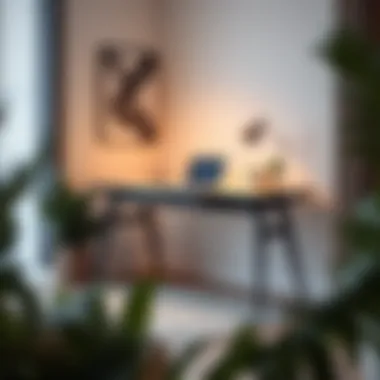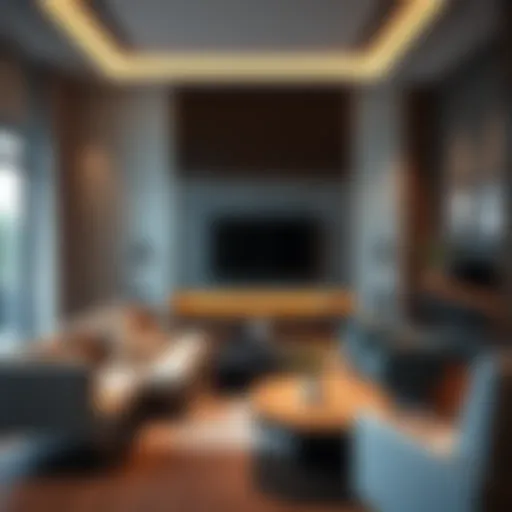The Versatile Appeal of Small Corner Writing Desks


Intro
In a world where space is often at a premium, the humble small corner writing desk emerges as a practical yet stylish solution for both work and leisure. These desks fit snugly into the often overlooked corners of our homes, turning them into productive hubs without sacrificing style. As more people embrace remote working and flexible arrangements, understanding how to choose the right corner writing desk can make a significant difference to one’s productivity and home ambiance.
The multifaceted nature of these desks lies not just in their size, but also in their design versatility and how they can seamlessly blend with various interior styles. Picture this: a chic, minimalist corner desk made from reclaimed wood that not only serves as a workspace but also enhances the aesthetic appeal of your living room. This is precisely where functional design meets personal expression.
As we take a closer look, this article explores different furniture trends and styles as they pertain to small corner writing desks. We’ll delve into major trends shaping the furniture landscape, the diverse styles that these desks embody, and essential insights on purchasing and maintaining these functional pieces. Whether you are a homeowner seeking to maximize your space, a designer looking for inspiration, or a DIY enthusiast aiming to craft a welcoming workspace, there’s something for everyone.
Join us as we navigate the one-of-a-kind characteristics and advantages these small corner writing desks offer, making them not merely furniture but critical components of our home and work life. This journey will illuminate the possibilities awaiting you, proving that even limited spaces can yield significant functionality and style.
Preface to Small Corner Writing Desks
Small corner writing desks hold a unique position in the landscape of home and office furnishings. As we delve into this topic, it becomes evident that these desks cater not just to functionality but blend seamlessly into the aesthetics of any space. In an era where living spaces are shrinking in size, these desks emerge as a beacon of hope for those in need of a workspace that doesn't impose on their surroundings. Their cleverly designed form facilitates a dual purpose—offering a dedicated area for writing or working while preserving precious square footage.
Through this discussion, we aim to shed light on various aspects that define these desks, from their diverse designs to the functional advantages they provide. Understanding their significance is crucial for homeowners, interior designers, and DIY enthusiasts who are looking to enhance productivity without sacrificing style.
Defining the Small Corner Writing Desk
When considering what qualifies a piece of furniture as a small corner writing desk, one must look at its dimensions and intended function. Typically, these desks are compact, often fitting snugly into an unused corner of a room, thereby maximizing space utilization. A hallmark of these desks is their ability to blend functionality with minimalism. They often feature clean lines and often prioritize efficiency over elaborate embellishments, catering to modern aesthetics. Often, these desks may include shelves or drawers to keep essential items within arm’s reach—all without overwhelming the visual landscape of a room.
The ideal small corner writing desk simultaneously asserts its presence while allowing the surrounding decor to shine. They can be found in various styles, comprising materials that echo personal taste and requirements, thus making them an essential aspect of modern interior design. In essence, a desk isn’t just a desk; it’s a reflection of one’s lifestyle and spatial strategies.
The Relevance of Space Optimization
Space optimization is no longer just a trend, it’s an essential focal point in today’s interior design and decoration strategies. In homes where every square inch needs to serve a purpose, small corner writing desks emerge as indispensable tools. By using corner spaces that are often neglected, they transform underutilized areas into valuable work zones.
Here are some essential points illustrating their relevance:
- Maximizing Usable Area: When furniture leverages corner spaces, it can release the rest of the room for more significant pieces or free movement.
- Flexibility in Design: These desks can readily fit into various environments—be it a cozy nook in a living room or a multifunctional space in a home office, providing the same functionality with less footprint.
- Encourages Organization: Their compact design often encourages owners to keep only necessary items within close reach, promoting tidiness and focus.
"A well-placed corner writing desk can turn any cramped area into a serene workspace, reflecting both style and practicality."
Overall, considering the incremental addition of a small corner writing desk can lead to profound positive shifts in how one interacts with their space. In further sections, we will discuss design perspectives and functional advantages that these desks provide, ensuring that readers are well-equipped to make informed choices.
Design Perspectives
When considering small corner writing desks, the design elements play a significant role in their charm and utility. Understanding styles and materials can help homeowners, designers, and DIY enthusiasts find desks that resonate with their aesthetic preferences while maximizing functionality. Each design aspect comes with its own set of benefits and considerations.
Styles and Aesthetics
Modern Minimalism
In the realm of modern minimalism, less truly is more. The clean lines and lack of ornamentation characteristic of this style foster an uncluttered workspace, which can greatly enhance one’s productivity. A modern minimalist corner desk often shines in its simplicity; crafted with a straightforward silhouette, it offers functionality without the baggage of excess.
The key characteristic here is the use of neutral colors—whites, blacks, and greys—paired with sleek finishes. This makes it a popular choice for urban dwellers who favor a tidy aesthetic. However, one must be cautious; while minimalism offers clarity, it may also feel cold without personal touches like plants or art.
Rustic Charm
Rustic charm brings warmth and coziness into a workspace. This style often utilizes natural wood and earthy tones, creating an inviting atmosphere perfect for creative endeavors. A small corner desk with rustic elements can include exposed joinery, rough-hewn edges, and reclaimed wood, giving each piece a story of its own. The beauty of this style lies in its imperfections.
The uniqueness of rustic architecture can foster a sense of comfort and familiarity. However, it may clash with modern home decor if not balanced correctly. Choosing complementary furnishings and accents can prevent a disjointed look and enhance the overall harmony of the space.
Contemporary Elegance
Contemporary elegance is all about marrying current trends with timeless grace. Typically showcased through sophisticated materials like glass or polished metals, this design allows for statements that stand out without overwhelming the space. A corner desk in this style often features chic curves or unique geometric shapes that can serve as a focal point.
One key characteristic of contemporary elegance is the seamless blend of form and function. While it is aesthetically pleasing, it often prioritizes practicality. However, the cost factor might be an issue, as these designs can be pricier. Yet, the investment usually pays off in terms of durability and style longevity.
Material Considerations
Wooden Options
Wood brings a certain organic warmth to the corner writing desk, which can enhance any workspace atmosphere. A solid wood desk is incredibly durable and can last decades with proper care. Many prefer wood due to its versatility; it can be stained, painted, or left in its natural finish, allowing homeowners to personalize their piece according to their style.
However, while the aesthetic appeal and longevity are clear advantages, wooden desks can be sensitive to humidity and temperature changes. Regular maintenance, such as polishing or applying varnish, is necessary to keep it looking fresh.


Metallic Frameworks
Metallic frameworks provide a contemporary look that stands the test of time. Often seen in modern designs, metal desks—especially those with powder-coated finishes—are easy to clean. They bring an industrial touch to home offices, perfectly suited for those looking to create a trendy atmosphere. The robust nature of metal equates to an excellent structure and stability.
Despite these benefits, metallic desks may lack the warmth and coziness that wooden options provide. You might need to balance this with softer accents, like cushions or textiles, to create an inviting environment.
Composite Materials
Composite materials offer an intriguing blend of different elements. Made from wood particles or fibers combined with adhesives, they often mimic the look of solid wood at a fraction of the cost. This versatility makes them a feasible choice for budget-conscious consumers who still want an elegant appearance.
While composite materials can be lightweight and easier to maneuver, some downsides exist. They are generally less durable than solid wood, and can be sensitive to water, making them a poor choice for heavy use without proper care.
Functional Advantages
The significance of functional advantages is not to be taken lightly, especially when we talk about small corner writing desks. These desks offer a multi-pronged advantage for those who are trying to carve out a workspace within the limited dimensions of their home. Their primary role is to optimize space while also providing necessary features for productivity. Choosing the right corner desk means understanding how it serves both practical and thoughtful needs in a living environment.
Efficient Use of Space
With urban living becoming increasingly cramped, every square foot counts. Small corner writing desks are designed to fit snugly into the often underutilized corners of a room, making the most out of what could be wasted space. By placing this type of desk in a corner, homeowners can open up the rest of the room—no need to sacrifice valuable floor area for a conventional rectangle desk that takes up much more space.
Moreover, the triangular or L-shaped designs often seen in these desks can facilitate better mobility and flow within a room. This means, you could easily navigate from one side of the room to the other without feeling hemmed in.
Enhancing Productivity
Productivity is fundamentally tied to the organization and functionality of a workspace. Small corner writing desks bring a myriad of benefits when it comes to boosting one’s output at work or during personal projects. Let’s break down a couple of key elements that contribute to increased productivity.
Ergonomic Benefits
One cannot overstate the importance of ergonomics in establishing a conducive workspace. A well-designed small corner writing desk can promote better posture, which reduces the likelihood of strain and fatigue over long working hours. This is particularly true when the desk allows for proper height adjustments and has space for comfortable seating arrangements.
The unique feature of many ergonomic desks is their ability to cater to the varying heights and sitting preferences of users. Adjustable components make them appealing to a wide range of users. If you find yourself hunched over a conventional desk, this could lead to back pain and, ultimately, lower productivity. Hence, investing in an ergonomic desk can pay dividends.
Increased Focus
In today��’s world filled with distractions, maintaining focus is a Herculean task. Small corner writing desks serve as dedicated zones for work, differentiating between leisure and labor. The very arrangement encourages putting your head down and dedicating time to tasks at hand.
These desks often come with built-in organizers which help keep supplies at hand but out of view during moments of distraction. The layout can actually create a psychological effect where users subconsciously associate that desk with productivity. Thus, working becomes a routine—a ritual even—rather than a monotonous chore.
In summary, the functional advantages of small corner writing desks extend far beyond mere aesthetics. The efficient use of scarce space coupled with enhancements in productivity makes these desks an attractive option for anyone looking to optimize their workspace. As we delve deeper into aspects like selection and integration, it becomes increasingly clear how vital these desks are in contemporary settings.
Selecting the Right Desk
Choosing the right desk may sound like a straightforward task, but when it comes to small corner writing desks, it’s a whole different ballgame. This is not just about picking something that looks nice; it's about finding a piece that fits your unique space, complements your personal style, and stays within your budget. Small corner writing desks serve as more than mere furniture; they become integral parts of your workflow, surroundings, and ultimately, your life.
Deciding on the appropriate desk can elevate your work experience, transforming a mere corner into a productivity oasis. Let’s break this down into manageable parts.
Assessing Space Dimensions
First things first, measuring your available space is crucial. Think about it: a stunning desk that seamlessly fits into your vision can turn into a monumental aggravation if it overcrowds your nook. Before making any decisions, pull out that trusty measuring tape.
- Consider Height and Width: Standard desk height is about 29 inches, and width can range widely. For small corners, you might want something compact yet functional. A desk of about 30 to 50 inches can be both space-efficient and usable.
- Depth Matters: A typical desk depth runs from 20 to 30 inches. Ensure that your choice allows you to pull out your chair without feeling crammed.
- Leave Some Breathing Space: Aim for at least a few inches around your desk for ease of movement. Also, think about where your chair will go. Being cramped can lead to frustration and hinder productivity.
Taking these measurements will help to narrow down the options significantly.
Evaluating Personal Style
Now that you know the dimensions, let’s dig into aesthetics, shall we? The desk you choose needs to fit not just your needs, but your vibe too. This is your workspace we’re talking about, maybe even a sanctuary of sorts.
- Consider Your Decor: Is your home a modern haven, rustic retreat, or a mix of styles? You want to choose a desk that will mesh effortlessly with existing elements in your space. For instance, a sleek glass desk could throw things off if your home leans heavily into a cozy, wooden ambiance.
- Function Meets Beauty: Think about how your desk will be used. If you do a lot of writing or drawing, consider options that allow for better ergonomics. Desks with adjustable tops offer flexibility, which could be useful, especially if your aesthetic leans toward versatility.
- Personal Touches: Sometimes, it’s all about the little things. Think about adding custom elements like paint or knobs for drawers to make it feel truly yours. This can be an opportunity to express yourself and create a corner that feels welcoming.
Budget Considerations
Last but not least, let’s tackle the elephant in the room: money. Deciding on a budget gives you a framework to work within, guiding you to realistic options. Keep in mind that quality often trumps quantity. You want a piece that lasts rather than one that looks good yet falls apart after a few weeks of use.
- Establish a Range: How much are you willing to spend? Quality small corner desks can vary from a couple hundred dollars to several thousand, depending on materials and design. Determine where you stand and stick to it.
- Look for Value: Don’t shy away from second-hand furniture, too. Thrift might just surprise you with hidden gems. Plus, giving a second life to someone else’s desk is an eco-friendly bonus you can feel good about.
- Consider Assembly Costs: If a new desk comes in pieces, factor in potential assembly costs unless you’re a DIY whiz. Check for warranties and return policies as well. If it doesn’t work out, you don’t want to be left high and dry.
By taking space, personal style, and budget into account, you can choose a small corner writing desk that marries functionality with your own unique taste, all while fitting comfortably into your lifestyle.


Integration with Home Decor
Integrating a small corner writing desk into home decor is not merely about finding a piece that fits; it’s about making a statement while optimizing the use of space. Living in contemporary homes often means dealing with limited room, making it crucial to choose furniture that not only serves a practical purpose but also complements the overall aesthetic of your surroundings. The desk should harmonize with other elements in the home, reflecting your personal style while remaining functional.
When contemplating the integration of these desks into your home, consider their role: they can be a focal point or a seamless addition to an already curated space. The desk can affect the look of a room, potentially boosting your interior’s overall coherence. Moreover, with the right design, a corner desk can help create a cozy nook that encourages productivity while enhancing your decor.
Coordinating Colors and Textures
Selecting the right colors and textures is essential when integrating your small corner writing desk into your home. Aim for harmony rather than chaos. For a modern setting, a sleek metal desk with glass accents can work beautifully alongside neutral tones and minimalist decor. Alternatively, a wooden desk with rich stains could bring warmth and comfort to a more rustic environment.
- Color palettes: Consider the primary and accent colors of your room. A desk in a bold hue can act as an eye-catching element, essentially grounding the space.
- Textures: Explore combining various textures to add depth. A smooth wooden desk can contrast nicely with soft textiles like a plush rug or cozy cushions, creating a balanced visual appeal.
Keep an eye on trends but prioritize what resonates with your style. Use visual cues from artwork, textiles, and other furniture pieces to guide your choices. Adding small decorative elements, like a plant or stylish lamp, can enhance both the desk and the surrounding area.
Blending with Existing Furniture
Your small corner writing desk should not appear as a foreign object in the room but rather blend with your existing furniture. Harmony can be achieved by considering the style and form of your other pieces. For instance, if your room features rounded furniture, a desk with soft edges can create a seamless flow throughout the space. On the flip side, if your home leans towards sharp lines and angular shapes, opt for a desk that mirrors that design to maintain balance.
- Wood matching: If you have wooden furniture, matching the wood type or finish of the desk can create an elegant unified look.
- Design styles: Integrate a desk that reflects the predominant style of your home. In a vintage-inspired setting, look for antique desks or modern reproductions that mimic vintage aesthetics.
- Functional pairing: Pair your corner desk with complementary pieces such as a stylish chair that not only matches visually but also enhances the ergonomics of your workspace.
Ultimately, successful integration with home decor hinges on thoughtful consideration of colors, textures, and existing furnishings.
Maintenance and Care
When it comes to small corner writing desks, maintenance and care play a essential role in ensuring their longevity and functionality. These desks, often tucked into cozy nooks, require specific attention to ensure they keep looking good and serve their purpose well. By understanding how to maintain these pieces, homeowners can enhance their workspace and preserve the desk's integrity over time.
Cleaning Practices
Keeping a small corner writing desk clean is not just about aesthetics; it directly influences its usability and durability. Regular cleaning not only removes dust but also prevents buildup that might scratch the finish or interfere with moving parts, such as drawers and hinges.
Here are some effective cleaning practices:
- Use a Soft Cloth: For daily dusting, a microfiber cloth can effectively pick up dust without scratching surfaces. This simple practice helps maintain the desk’s appearance.
- Mild Cleaning Solutions: When deeper cleaning is needed, opting for a mild soap diluted in water is ideal. Avoid strong chemicals, as they can harm the finish.
- Address Spills Promptly: Accidental spills happen; quickly blot them with a soft cloth rather than rubbing, which can spread the liquid or damage the wood.
Preventing Damage
Preventing damage is crucial for maintaining the elegance and functionality of a small corner writing desk. Two significant factors need attention: temperature control and moisture prevention. Each of these considerations holds importance that can alter the desk's condition.
Temperature Control
Temperature control is vital for preserving the material of a writing desk. Extreme temperatures can warp or crack wood, ruining its structural integrity. Maintaining an appropriate environment is key.
One key characteristic of effective temperature control is the avoidance of direct sunlight. Sunlight can not only raise the desk's temperature but also lead to fading of its finish over time. Keeping the desk in a well-insulated area where temperatures are consistent can be a beneficial choice in protecting the desk from heat fluctuations.
A unique feature of paying attention to temperature is the reduction in energy costs. By managing the room's temperature effectively, not only are the desk and its surroundings preserved, but energy efficiency is also enhanced, serving multiple purposes.
Moisture Prevention
Moisture is another significant enemy of small corner writing desks. The presence of humidity can cause serious problems, such as mold growth or warping of wooden components. Preventing moisture allows for a cleaner and healthier workspace.
A key benefit of moisture control is that it preserves the desk’s appearance and functionality. Using dehumidifiers or silica gel packets in drawers can be an effective approach. Additionally, employing coasters for drinks or placing plants at a distance can minimize potential water damage.
One unique feature of moisture prevention is its direct correlation with health. Maintaining dry conditions not only enhances the desk's longevity but also contributes to a healthier environment free of mold and bacteria growth.
In summary, taking proper care of a small corner writing desk through cleaning and preventative measures results in a well-maintained and functional workspace. The combination of regular upkeep and attentive care can not only significantly increase the desk's lifespan but also ensure that it continues to be a valuable part of the home or office for years to come.
Eco-Friendly Options
In today's world, where environmental concerns have taken the center stage, the choice of furnishings, including small corner writing desks, plays a significant role. Opting for eco-friendly options not only benefits the planet but offers homeowners, designers, and DIY enthusiasts a path to sustainable living. The relevance of incorporating these choices is paramount, especially since many people are seeking ways to reduce their carbon footprint. Sustainable practices in furniture selection and maintenance contribute to healthier living environments while promoting the durability and aesthetic appeal of your spaces.
Sustainable Materials
Choosing sustainable materials is a key aspect when it comes to eco-friendly desks. For instance, using wood sourced from responsibly managed forests, such as bamboo or reclaimed wood, can significantly lower the environmental impact. These materials are renewable, durable, and often have a unique character that synthetic materials lack. Moreover, furniture created from recycled metal or glass also contributes positively as these materials can be repurposed endlessly without losing structural integrity.
Some notable sustainable materials include:


- Bamboo: Fast-growing and extremely strong, bamboo is a standout material. Its rapid growth makes it a renewable alternative to slower-growing hardwoods.
- Reclaimed Wood: This wood has a past life and is often salvaged from old buildings or furniture, giving it a rich history while keeping it out of landfills.
- Recycled Metals: Not only strong, but also versatile, recycled metals, like steel, reduce the need for raw material extraction.
Investing in small corner writing desks made from these materials not only helps the environment but also provides a touch of character and artistry to your workspace.
Recycling and Upcycling Ideas
Creativity meets sustainability in the realm of recycling and upcycling furniture. Rather than tossing out an old desk or storing it away, consider repurposing it into something functional for your corner space. This practice not only minimizes waste but also offers a cost-effective solution for those looking for unique, personalized pieces.
A few ideas for recycling and upcycling corner writing desks include:
- Refinishing: A simple coat of paint or wood stain can breathe new life into an old desk, changing its appearance and allowing it to fit seamlessly into a modern aesthetic.
- Repurposing: Use an old writing desk as a crafting station or a display area for plants. This way, it doesn’t just serve a single function, it actively enriches your space.
- Creatively Combining Pieces: Two smaller desks could be merged into one larger, corner-friendly unit with a little DIY ingenuity. This adds value and personal touch without the need to shop for brand new pieces.
In the words of environmental advocates, "Every little bit helps." Each choice strengthens the shift towards a sustainable lifestyle.
The essence of eco-friendly options in furniture goes beyond aesthetics. They represent a conscientious choice, marrying form with function while caring for our planet. As the awareness grows, the movement towards sustainability in home decor and furniture only appears to be gaining momentum.
DIY Corner Writing Desk Projects
The allure of a DIY corner writing desk is not merely in its function but also in the pride that comes from creating something with your own hands. This section dives into why embarking on a DIY project for a corner writing desk can be not only a fulfilling endeavor but also a practical one for any space-starved home or office. The importance of these projects lies in their ability to marry functionality with personal expression. With a small corner writing desk, homeowners can maximize their living environments while infusing them with individuality.
Basic Construction Guidelines
When setting out to create your own corner writing desk, one must first lay the groundwork, quite literally. Here are some key steps that will guide you through the process:
- Measure Your Space: Before anything else, grab a tape measure. Ensure to get the dimensions of your intended workspace, including corners and clearances. This info is vital to avoid any “whoops, it doesn't fit” moments.
- Select Your Materials: Whether it’s plywood for the top or solid wood for legs, choose materials that suit the overall aesthetic you envision, but also consider durability. For example, reclaimed wood might bring a rustic feel while ensuring strength.
- Create a Blueprint: Sketch a plan of your desk. Include dimensions, shapes, and even any compartments you might want for storage. This will serve as your roadmap, preventing you from going off the rails during the build.
- Assemble Your Tools: Gather all the tools you’ll need. A drill, saw, and screws are typically the basics, along with sandpaper and paint or varnish if you plan to finish it off. Make a checklist to make sure you have everything.
- Build the Frame: Start with a sturdy frame that can support your desk surface. Use strong joints like mortise and tenon, or even simple screws. Stability is key – a wobbly desk loses its charm quickly.
- Attach the Surface: Once the frame is complete, attach the desk surface. Be mindful of how the desk will be used, ensuring that it’s at the right height for both sitting and standing positions, especially if you'll be pairing it with an ergonomic chair.
Customization Techniques
With the basic structure complete, it’s time to jazz things up a little:. Customization is where your creativity can flourish. Here are a few ideas:
- Finish Choices: Stains, paints, or natural oils can dramatically change the appearance of your desk. For a modern look, consider sleek matte finishes; for a warm, inviting feel, a rich stain can work wonders.
- Incorporating Storage: Adding shelves or compartments can enhance functionality. Consider under-desk storage for books, stationery, or anything else that might clutter your workspace.
- Lighting Solutions: Installing a small lamp or LED strips can transform your desk into a cozy workspace. Consider using smart bulbs that adjust brightness based on the time of day or personal preference.
- Adding Personal Touches: Lastly, infuse your desk with personality. Whether it’s a corkboard for inspiration or unique handles on drawers, every little detail adds up.
It’s essential to remember that a DIY desk is an extension of your unique style, so don’t shy away from making it distinctly yours!
In the end, the process of creating your own corner writing desk is not just about practicality; it's about making a statement in your space. Each cut, join, and paint stroke tells a story - your story. From the simple to the complex, your DIY project can cater to both aesthetic desires and functional needs, thereby forming an integral part of your home or office environment.
Case Studies of Successful Implementations
Exploring the practical applications of small corner writing desks through real-world examples offers invaluable insights into their effective integration and adaptability. Case studies not only showcase aesthetic aspects but also highlight the functional benefits these desks provide in different scenarios. Through these examples, it's clear how such desks cater to diverse needs, space constraints, and personal styles, while also enhancing productivity—an essential aspect for both residential and commercial settings.
Residential Examples
In residential spaces, smaller corner writing desks have been increasingly sought after by homeowners looking to maximize limited areas without sacrificing design. For instance, consider a cozy apartment in the heart of a bustling city, where every inch of space counts. A sleek, walnut-finished corner desk fits snugly into an L-shaped nook by a window, serving not only as a writing station but as a charming display area for houseplants and decorative items. The natural light streaming in enhances the workspace, creating an inviting atmosphere for daily writing tasks.
Another successful application can be found in a suburban home, where a white corner desk is positioned against pastel-colored walls in a child’s playroom. This intentionally designed space allows for homework and creative activities. The desk has rounded edges for safety and includes integrated storage to keep art supplies and books tucked away neatly. This thoughtful design promotes organization and helps establish a productive zone for young learners.
Utilizing the underutilized space in the hallway can also generate innovative setups. By incorporating a multi-functional desk that doubles as a console table, homeowners can create a seamless transition from living areas to home offices. This approach not only declutters but also introduces functionality without compromising the home's aesthetics.
Commercial Adaptations
When it comes to the commercial realm, small corner writing desks demonstrate remarkable versatility in various business environments. Take a tech startup in a funky, open-plan office—here, compact corner desks equipped with innovative cable management systems promote collaboration while providing necessary privacy for focused work. Each desk is customized with brightly colored dividers that transform ordinary spaces into vibrant, stimulating working environments.
In contrast, a legal firm utilizes elegant, minimalistic corner desks made from high-quality glass and steel. The desks are not only stylish but also allow natural light to pass through, creating an airy atmosphere. Each workstation is harmoniously integrated with ergonomic chairs and tasteful bookshelves, promoting not just creativity but also professionalism in a client-focused setting.
Furthermore, in a co-working space that caters to freelancers, adjustable corner desks equipped with built-in power outlets have become the norm. Such desks enable users to tailor their workstations according to their comfort levels, fostering productivity and versatility. It’s interesting to note how such adaptations serve as a model for other businesses, promoting flexible work environments that adapt to the evolving needs of modern professionals.
"Small corner desks have a way of making even the tiniest areas feel purposeful and stylish. They maximize space while offering users a chance to define their own work zones."
Through these case studies, it becomes evident that the applications of small corner writing desks are as vast as they are valuable. They meet the diverse needs of both homeowners and businesses, making them an essential investment for optimizing space without compromising on style or functionality. The key takeaway here is that the right corner desk can not only transform a space but can also enhance overall productivity, crafting a personalized atmosphere tailored to any lifestyle.
The End
In wrapping up our discussion about small corner writing desks, it’s paramount to grasp the significance of these versatile pieces of furniture in both aesthetic and functional capacities. Corner desks optimize space, making them a stellar choice for anyone looking to make the most of their available area, no matter how limited. In today’s world, where the concept of home offices continues to evolve, these desks serve as a focal point in enhancing productivity and establishing a dedicated work environment.
Recap of Key Points
- Space Optimization: Small corner writing desks are designed to fit snugly into corners, utilizing areas that might otherwise go neglected. This trait is particularly beneficial in smaller homes or apartments, providing a dedicated workspace without overwhelming the room.
- Design Versatility: With a range of styles available, from modern minimalism to rustic charm, these desks can blend seamlessly into various decor themes. They can also add a touch of individuality based on the owner’s taste.
- Functional Benefits: Besides saving space, they can improve productivity. Many designs emphasize ergonomic considerations, ensuring users maintain comfort during long working hours.
- Customization and DIY Possibilities: There’s something to be said for personalizing a desk to make it distinctly yours. Whether through painting, stenciling, or adding personal touches, DIY enthusiasts can transform standard designs into unique masterpieces.
Final Thoughts on Corner Writing Desks
Ultimately, corner writing desks are more than just practical solutions; they embody the intersection of functionality and style. For homeowners juggling limited space and the urgent need for effective workspaces, these desks aren’t merely furniture. They represent an opportunity to carve out personal sanctuaries that promote focus and creativity. As we navigate the evolving dynamics of home offices, investing in a small corner writing desk may just be one of the most astute decisions an individual can make. With the right desk, anyone can find both form and function beautifully intertwined, setting the stage for enhanced productivity and inspiration in their daily tasks.
"Choosing the right corner desk can transform not just your space but how you experience your daily tasks."







